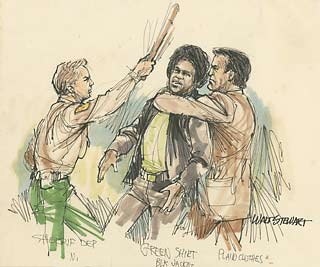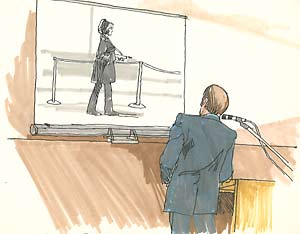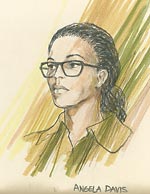UC Berkeley Press Release
 |
The late Walt Stewart's sketch of a courtroom melee during the 1971 Soledad Brothers trial is one of the gripping trial images on display in a new exhibit at the Bernice Layne Brown Gallery. (Images courtesy of the Bancroft Library) |
"Two Artists of the Courtroom" on exhibit
BERKELEY – That's Squeaky Fromme, hurling a partially bitten apple at the prosecutor in her trial for trying to murder President Ford. Over there is Patricia Hearst on the witness stand, a rifle in her arms. There's Angela Davis, staring from an FBI "Most Wanted" poster, and the original manuscript of "The White Album," a book by Joan Didion that linked the end of California's "Age of Aquarius" to bloody murders by the Manson family.
All are among dozens of courtroom sketches and related materials from the 1970s and early '80s now in the Bernice Layne Brown Gallery of the University of California, Berkeley's Doe Library. On display is the work of two of the nation's most prolific and well-known courtroom artists: Rosalie Ritz and the late Walt Stewart.
 Two views of the bank robbery trial of Patricia Hearst: Hearst holding a gun while on the witness stand (drawn by Rosalie Ritz), and an FBI agent showing jurors a surveillance camera's image of Hearst during the robbery (drawn by Walt Stewart).  |
The exhibit, which runs through March 31, provides a glimpse of seven notorious trials that helped define a tumultuous California at the time. The defendants highlighted include:
Charles Manson, a cult leader and mastermind of the 1970 Tate and LaBianca murders in Los Angeles. His followers called him "God" and "Satan." Manson and three of his "family" members were convicted of murder. He said he was influenced by the song, "Helter Skelter," on the Beatles' "White Album."
* Imprisoned activists George Jackson, John Cluchette and Fleeta Drumgo, known as the Soledad Brothers. When a guard was slain at Soledad prison, the three were charged with his murder. Jackson was transferred to San Quentin State Prison and was killed by guards three days before he was to go on trial.
* Ruchell "Cinque" Magee, a prison inmate who was testifying in a trial when George Jackson's brother burst in and distributed guns to Magee and others. They then took the Marin County judge and three jurors hostage. Guards from San Quentin State prison opened fire on their getaway vehicle, killing the judge, Jackson and two others.
* Angela Davis, a UCLA philosophy professor, social activist interested in prisoner rights, and a friend of George Jackson. She was charged with conspiracy in connection with the Marin County incident. Her conviction was reversed in 1972 after she spent 16 months in jail. Today, she teaches at UC Santa Cruz.
* Heiress Patricia Hearst, kidnapped at the age of 19 from her Berkeley apartment by a small guerilla group calling itself the Symbionese Liberation Army. She was convicted of helping the group rob a bank, but was later pardoned.
* Black Panther Party founding member and spokesman Eldridge Cleaver, also author of "Soul on Ice," a powerful collection of essays about race. Wounded in a shootout between party members and Oakland police, he was charged with attempted murder and went into exile for several years. After his return, charges were dropped, and Cleaver was put on probation for assault. He died in 1998. The Bancroft Library at UC Berkeley now has his papers.
* Larry Layton, an anti-war activist turned People's Temple member, was sentenced to life in prison in 1981 for the attempted murder of Rep. Leo Ryan (D-Calif.) during Ryan's 1978 visit to Guyana to investigate the former San Francisco-based cult. Ryan and four others in his group were killed. Some 900 People's Temple members and leader Jim Jones died of suicide or murder. Layton was the only person convicted of a crime in connection with the mass deaths in Jonestown, named after the temple leader.
Jack von Euw, curator of The Bancroft Library's pictorial collections, said he combed through approximately 4,000 drawings done over 30 years by Ritz and Stewart.
"I decided against simply exhibiting a 'rogues' gallery' composed of notorious criminals," he said. "Instead, I thought it would be more useful to show the differing visual approaches of two successful courtroom artists who covered many of the same trials."
  Drawings of activist Angela Davis by Stewart (left) and Ritz. |
Ritz's sketches often depict more emotion and action, while Stewart's work might be described as more technically accurate.
Von Euw made final selections based on a trial's historic interest to California, whether it was representative of the era, if the trials were connected to each other, and whether the sketches represented the artists -- as well as the two individual collections -- at their best.
The sketches and related materials on display also reflect state history at some of its most unsettled periods, when some civil rights and political struggles led to conflict, controversy and attempted revolution.
Von Euw said courtroom artists such as Stewart and Ritz played critical roles as the public's visual interpreters of many major criminal proceedings. While legal scholars debated the scope of a 1965 U.S. Supreme Court ruling overturning the conviction of Texas financier Billy Sol Estes because his trial was televised, many judges opted to exclude TV cameras and newspaper photographers from their courtrooms.
Since then, television broadcasts from courtrooms have become relatively common, but it still is not unusual for judges in extremely high profile cases to block cameras while leaving the door open for quick artists with paper, pencils and pens.
Stewart launched his courtroom art career at the Dallas trial for Jack Ruby, who was convicted of slaying Lee Harvey Oswald as Oswald approached a courthouse to be arraigned for the assassination of President John F. Kennedy. Trained as a commercial artist, Stewart cast aside agency work to follow a different path.
He went on to cover the trials featured in the Doe Library exhibit, and hundreds more. Among them: trials of the Bay Area's so-called "Zebra Killer"; the late Dan White, a San Francisco supervisor who shot and killed San Francisco Mayor George Moscone and Supervisor Harvey Milk; and the "Unabomber," Ted Kaczynski. A longtime Marin County resident, Stewart won three Emmys for his work.
KRON-TV's Don Knapp in San Francisco worked with Stewart intermittently after Knapp arrived in the Bay Area in 1969. "If you watched him draw in court, he would just put that pen to the paper . and that face would emerge," said Knapp. "And it was always dead accurate. It was always good to watch."
But Knapp said he remembered Stewart lamenting his early frustrations in covering the Hearst trial and saying "how difficult it was to catch her face." Stewart spent an evening in a bar, and drew and drew and drew, Knapp said, finally capturing Hearst's image to his satisfaction.
Jeannine Yeomans worked as a reporter alongside Stewart on several trials, including those for Hearst and Davis. A psychiatrist testifying in the Hearst trial asked that his face not be shown to the public, she said, so Stewart drew an upside-down grocery bag over his face with two holes for eyes. The sketch appeared on the TV news.
Stewart was "very witty, ready to laugh or ready to supply a laugh," Yeomans said, noting that the traits often helped diffuse the tension or boredom that often accompanies a long and difficult trial.
"There were these cases with murder, mayhem and politics, and Walt -- with his tremendous sense of humor -- always helped to lighten the mood in a professional way," said Yeomans.
Stewart acknowledged the fruits of his own work with a personal license plate on his Cadillac: THX JDL. That, said Knapp, stood for "Thanks John DeLorean," the car designer and entrepreneur whose lengthy trial for drug trafficking was covered artistically and lucratively by Stewart.
Ritz was trained in art school and started at the age of 14 at Layton Art College through an arrangement when the school saw her exceptional talent. At 16, she was part of a five-woman group that bought an old car and toured traveling circuses and county fairs, where the artists earned money by sketching portraits.
She married and pursued painting in Washington, D.C., where she also began to sketch Congressional proceedings from which cameras were excluded. She branched out to cover criminal cases, from preliminary hearing to trial and sentencing, and could draw a whole jury in a few seconds. Ritz recalls producing 18 drawings a day, and Stewart chiding her that she must be cheating.
"It was fun," Ritz said. "It was good, and I was scared a lot of the time."
She went into Black Panther Huey Newton's jail cell to interview and sketch him, and did the same with Ruchell Magee. Ritz said she was pepper sprayed while covering the burning of draft cards.
Despite the often frantic, frightening and confusing nature of the events she covered, Ritz said she hopes that the idealism and dedication of the involved activists and their defenders are never forgotten.
"That era I'm sure is past," she said. "These were people who really believed in doing the right thing."

